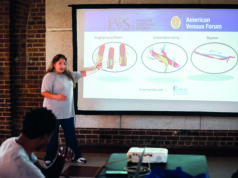
Use of the Gore Tag thoracic branch endoprosthesis (TBE) “offers a safer alternative” to traditional thoracic endovascular aortic repair (TEVAR) with left subclavian artery (LSA) coverage in blunt thoracic aortic injury (BTAI) requiring zone 2 coverage for zone 2 or proximal zone 3 injuries without requiring a concomitant or delayed subclavian revascularization, according to a new study delivered at the 2025 Society for Clinical Vascular Surgery (SCVS) Annual Symposium in Austin, Texas (March 29–April 2).
Kathryn DiLosa, MD, a vascular surgery resident at the University of California, Davis in Sacramento, California, revealed how from 2005–2024, 13 patients had TBE repair for BTAI at UC Davis, with 48 receiving TEVAR with LSA coverage. Technical success—device delivery with exclusion of injury—was 100% in both groups. Among the TEVAR cohort, nine patients had LSA revascularization. There were no complications in the TBE cohort, DiLosa and colleagues found, while 12 patients in the TEVAR cohort experienced a complication, including wound infection, arm ischemia, stroke, endoleak and retrograde dissection. No aortic-related mortalities were observed. TBE side branch patency and BTAI exclusion was 100% at mean follow-up of 18.5 days. Similarly, BTAI was excluded in all TEVAR patients at follow-up.
The UC Davis experience is characterized by the institution’s geographical surroundings in tandem with its early access to the TBE device, explains DiLosa in an interview prior to SCVS 2025. “Here at UC Davis, we are surrounded by tons of very rural highways—mountain highways—so there is a lot of blunt trauma that we deal with,” she says. “As a result, we have a massive collection of patients who have had prior blunt thoracic aortic injuries that we have managed and that has given us a nice cohort to look at some unique features of those injuries and the management of them.”
DiLosa highlights the significance of the UC Davis findings: “Previously, it has been suggested covering the LSA is reasonable, especially if somebody has a bad injury, and they just need it done quickly, where you can come back later. This has been the teaching. But I think now, as we’re seeing new devices that offer something that can be done relatively quickly and efficiently with an off-the-shelf device, our recommendations need to change to match the evolution of endografts.”
The data, says DiLosa, confirm a number of prior studies showing that “15–30% of patients that have coverage of the left subclavian may need revascularization at some point or other.
“We observed that roughly 20% of patients in our cohort needed revascularization for one reason or another, or had revascularization. When you are considering that one-in-five patients that gets a repair for an emergent situation will potentially need a bypass, our practice has generally shifted to use the TBE device in any repairs that are going to require coverage of the left subclavian, because, in our experience, we are fairly facile with the device and we are able to complete that repair in just over an hour.”
When the device is available, the TBE should be considered if coverage of the LSA is required to prevent adverse outcomes, DiLosa and colleagues conclude. “One thing that should be made clear is that not all patients with a blunt aortic injury need a repair that involves coverage of the subclavian artery,” DiLosa adds. “However, when coverage is necessary, a branched endograft maintains subclavian artery perfusion, and minimizes stroke and extremity ischemia risk.”












